![]()
![]()
![]()
Use LEFT and RIGHT arrow keys to navigate between flashcards;
Use UP and DOWN arrow keys to flip the card;
H to show hint;
A reads text to speech;
155 Cards in this Set
- Front
- Back
- 3rd side (hint)
|
The constituents which are released by digestion |
Nutrients |
|
|
|
Three Metabolic Functions of Nutrients |

|
|
|
|
Important roles of nutrition in animal production |

|
|
|
|
The Science of Feed Preparation |
Animal Nutrition |
|
|
|
Food animals comprising og any natural occuring ingredient for the purpose of sustaining growth |
Feed |
|
|
|
Regulated slection of feed ingredieny which is consumed by animals on a prescribed schedule |
Diet |
|
|
|
Feed items that a mixture is made of |
Ingredients |
|
|
|
Added to the basic feed mixture for specific purpose |
Additives |
|
|
|
Fixed amount of feed for one animal, fed on a definite period |
Ration |
|
|
|
The ration whicj providr animal with the proper amount proportion |
Balanced Ration |
|
|
|
Single feed which has all of the dietary essentials exept water |
Complete ratjon |
|
|
|
The gain in weight produced by 1kg of feed |
Feed Conversion Efficiency |
|
|
|
The amount of feed necessry to produce 1kg of weight |
Feed Conversion Ratio |
|
|
|
A unit measurement used for calculating the amount of energy by various foods |
Calorie |
|
|
|
Poor quality feeds with more than 35%TDN snd 18% CF |
Forage |
|
|
|
Hsve less than 18% CF and More than 60% TDN |
Concentrate |
|
|
|
The most importsnt dietary essential |
Water |
|
|
|
Sources of Water |
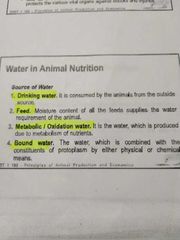
|
|
|
|
Factors affecting water requirement |
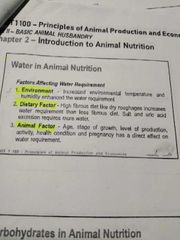
|
|
|
|
Two groupsnof Carbohydrates based on Digestibility |
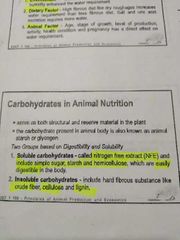
|
|
|
|
The term for stored and excess carbohydrates |
Glyogen and Fat |
|
|
|
Simplest sugars divided inyo sub-groups depending upon the number of atoms present |
Monosaccharides |
|
|
|
Di, tri and tetra polysaccharides |
Oligosaccharides |
|
|
|
Most occuring oligosaccharides |
Disaccharides |
|
|
|
Are tasteless and insoluble amorphous compoubds with a high molecular weight |
Non-Sugars |
|
|
|
Polymers or Monosaccharide derivatives |
Homopolysaccharides |
|
|
|
Mixed polysaccharides |
Heteropolysaccharides |
|
|
|
Factors affecting digestion of carbohydrates |
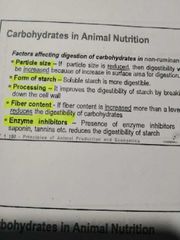
|
|
|
|
Factors affecting digestion of carbohydrates in ruminants |
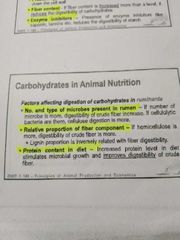
|
|
|
|
Another factor in Carbohydrate digestion in Ruminants |

|
|
|
|
It stimulates digestion of cude fibers because they supply vitamins required for microbial growth |
Supplementation of Green Forages |
|
|
|
Synthesis of carbohydrates in the cels is done by number of enzymes |
Glucose Metabolism |
|
|
|
This process glycogen, glucose, galactose, snd fructose are broken down to pyruvic acid and lactic acid with the absencr of molecular oxygen |
Glycolysis |
|
|
|
Conversion of the two pyruvic acid molecules into two molecules of acetyl coenzyme A(Acetyl CoA) |
Tricarboxylic acid cycle |
|
|
|
Glycogen synthesis from simple sugsrs in the body tissues. Where simple sugars are converted to glycogen by enzymes |
Glycogenesis |
|
|
|
Process degredation of glycogen to gluxose 1-phosphate |
Glycogenolysis |
|
|
|
Is formed by condensation of one glucose and one galactose formula |
Lactose, Lactose Synthesis |
|
|
|
When excess sugar is transformed into fat |
Fat synthesis from glucose |
|
|
|
The two components that synthesize to givr fat |
Glycerol and fatty acids |
|
|
|
Are complex organic nitrogenous compounds made up of amino acids |
Proteins |
|
|
|
Cannot be synthesized by the animal and so must be present in the protein of the feed |
Essential Amino acids (indispensable) |
|
|
|
Needed by the animals that can be synthesized from other amino acids |
Non-essential amino acid(dispensable) |
|
|
|
Present in protein in the least amount in relation to the animal's need for that particular amino acids |
Limiting Amino Acids |
|
|
|
Proteins that are insoluble and very resistant to animal digestive enzymes |
Fibrous Proteins |
Eg. Collagen, elastin, keratin |
|
|
Includes all the enzymes, antigens and hormones that are proteins |
Globular Proteins |
Eg:albumin, globulin, histones |
|
|
Composed of simple protein with some non protein substances as prosthetic group |
Conjugated Proteins |
Glycoprotein, lipoprotein, phophoprotein |
|
|
Class of proteins includes those substances formed from simple and conjugated proteins |
Derived proteins |
|
|
|
Are long chain organic acids usually frrom 4 to 30carbon atoms, and a long non polar hydrocarbon tails which gives thrm their hydrophobic and greasy nature |
Fatty Acids |
|
|
|
Are required in relatively large amount and in most cases they are used in the synthesis of tissues |
Macro Elements |
|
|
|
Important Macro Elements |
Calcium, Phosphorous, Magnesium, Salt, Potassium, Chlorine, Sulfur |
|
|
|
Required in trace amounts and usually functions as an activators as a component of enzymes, expressed jn PPM |
Micro elements |
|
|
|
Important Micro Elements |
Fe, Cu, I, Co, Zn,Mn, F, Se, Mo, Cr, Ni, Si, Sn, and V |
|
|
|
Are esters of fatty acids with trihydric alcohol glycerol. |
Simple Lipids |
|
|
|
Same general structure and chemical properties but diffetent physical characteristics |
Fats and Oils |
|
|
|
Essential Fatty Acids, |
Linoleic, linolenic and arachidonic acids |
|
|
|
Functions of Lipids |
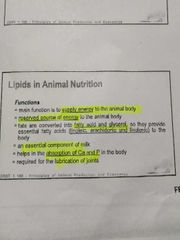
|
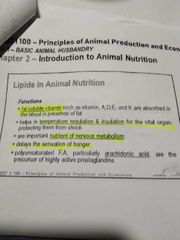
|
|
|
Function of Proteins |
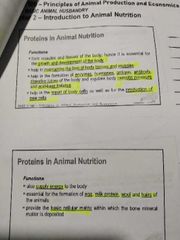
|
|
|
|
If particle size is reduced, then digestability will be increased |
Particle size |
|
|
|
Soluble starch is more digestable |
Form of starch |
|
|
|
It improves digestabiliyy of starch by breaking down the cell wall |
Processing |
|
|
|
If fiber content is inscreased more than a levrl, it reduces the digestability of carbohydrates |
Fiber content |
|
|
|
Presence of saponin reduces the digestability of starch |
Enzyme inhibitors |
|
|
|
If number of microbe is more, digestability of crude fiber increased |
Number and type of microbes present in rumen |
|
|
|
If hemicellulose is more, digestability of crude fiber is more |
Relative proportion of fiber component |
|
|
|
Increased protein level in diet stimulates microbial growth and improves digestability |
Protein content in diet |
|
|
|
Increased fat content in diet gives a protective layer in stomach |
Fat content in diet |
|
|
|
Part of a respiratory pigment snd hemoglobin, helps in the utilization of oxygen in blood |
Iron |
|
|
|
Lower weight gain, labored breathing after mild excercise, and decrease resistance to infection |
Iron deficiency |
|
|
|
Acts as catalyst in the formation of hemoglobin and provides oxygen absorption power to red blood cells, necesarry for the pigmentation of hair, fur and wool |
Copper |
|
|
|
Necessary for the proper functioning of the thyroid gland |
Iodine |
|
|
|
Causes falling of bair, rough and hard skin, reproductive failure. |
Iodine deficiency |
|
|
|
Plays an important role in the sysnthesis of vitamin B12 in rumen and synthesis of DNA |
Cobalt |
|
|
|
Essential part of the insulin hormone, plays a key role in cell and antibody mediated responses |
Zinc |
|
|
|
A vital nutrient in the synthesis of chondroitin sulfate, an enzyme activator, detoxifies free oxygen radicals |
Manganese |
|
|
|
Closely related to vitamin E, and acts as an antioxidant, essential to prostsglandin synthesis, part of an enzyme glutathione peroxidase, protective effect against the heavy metals |
Selenium |
|
|
|
Reduces the incidence of dental carries |
Fluorine |
|
|
|
Component of the enzyme xanthineoxidase, important to poultry for uric acid formation |
Molybdenum |
|
|
|
Plays a role in the maintenance of the configuration of the RNA molecule, primary component of glucose tolerant factor |
Chromium |
|
|
|
Helpful in the transmission of light stimuli in the eye |
A-Retinol |
|
|
|
Promotes normal development of bone, mobilizatjon of Ca from bone to extra cellular fluid compartment |
D-Calciferol |
|
|
|
Acts as a biological antioxidant with glutathione peroxidase enzyme, contains selenium |
E-Tocopherols |
|
|
|
Synthesized in tbe body of ruminants by the action of rumen microbes, necessary for the formation of prothrombin, which is important itermediate of the blood clotting process |
K-Phylloquinone |
|
|
|
Two vitamins and the hormone of sulfur |
Biotin and Thiamine, Insulin |
|
|
|
F:activator of phosphates and takes an active part in glucose metabolism |
Magnesium |
|
|

|
Magnesium |
|
|
|
Retarded growth in poultry with severe edema and subcutaneous hemmorhage /bloody diarrhea in swine |
Pantothenic Acid deficiency (B5) |
|
|
|
A typical nerve disease that is characterized by movement of hind leg become stiff and jerky |
Goose stepping gait |
|
|
|
Reduced in erythropoeisis, anemic apperance and perosis in poultry, macryotic anemia in swine |
Folic Acid deficiency |
|
|
|
A deficiency in Manganese among Juvenile avians |
Perosis |
|
|
|
The factor against egg white injury |
Biotin - B7 |
|
|
|
Combined with biotin to form the egg white and prevent its absorption from the intestine |
Avidin |
|
|
|
Alopecia and dermatitis, characterized by brownish exudates |
Biotin deficiency |
|
|
|
Can be synthesized in the liver from methionine |
Choline |
|
|
|
Deficiency in phospholipids and causing fatty liver |
Choline Deficiency |
|
|
|
Are essential for the maturation of RBC, paired with Folic acid for the formation of DNA |
B12-Cyanocobalamin |
|
|
|
Pernicious anemia in humans, poort feathering and kidney damage in poultry, dermatitis in swine |
B12 deficiency |
|
|
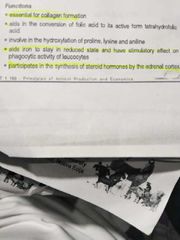
|
Vitamin C |
An antioxidant, |
|
|
Vitamin C deficiency |
Scurvy |
|
|
|
Refers to the constructive process |
Anabolism |
|
|
|
The destructive process |
Catabolism |
|
|
|
Nutrients are absorbed to the gastrointestinal tract |
Absorptive state |
|
|
|
Period where there is no absorption |
Postabsorptive state |
|
|
|
The removal of nitrogen |
Deamination |
|
|
|
Are particles that contain lipids, cholesterol, amd proteins in various ratios. |
Lipoproteins |
|
|
|
An enzyme bound to endothelial cells that acts on their triglycerides to release fatty acids |
Lipoprotein lipase |
|
|
|
The increased use of fatty acids by other cells reduces the overall need for glucose and conserve it for use of neurons |
Glucose sparing |
|
|
|
Decreases in blood glucose stimulate the mobilization of fatty acids from adipose |
Lipolysis |
|
|
|
Is a metabolic syate characterized by an increase in blood ketones, a reduction in urine and bloos pH, and ketones in the urine. |
Ketosis |
|
|
|
The term for the collective metabolic processes by which liver cells produce glucose fron non-carbohydrate substraes, such as amino acids. |
Gluconeogenesis |
|
|
|
Acids capavle of preventing skin dermatitis caused by the deffieciency of these acids. |
Essential Fatty Acids |
Hdyrogenation of linoeic acid in the rumen will make available of more quantities of the said acids. |
|
|
Functions of Minerals |
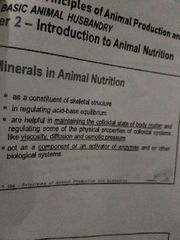
|
|
|
|
Minerals which have been proved to have a metabolic role in the animal body. |
Essential Mineral elements |
|
|
|
Most of mineral elements are simply component of tissues but do not play any essentials metabolic role in the animal body. |
Non-essential mineral elements |
|
|
|
With P, serve as the major structural elements of skeletal tissue |
Calcium |
|
|
|
Calcium defficiency in young animals. |
Rickets |
|
|
|
Calcium defficiency Occuring in adult animals |
Osteomalacia |
|
|
|
Characterized by a decrease in bone mass |
Osteoporosis |
|
|
|
Parturient paresis; calcium tetany |
Milk fever |
|
|
|
Good sources of calcium |
Milk, green leafy crops specially legumens |
|
|
|
Poor sources of calcium |
Cereals and roots |
|
|
|
Major portion in the animal body distributed in the bones |
Phosphorus |
|
|
|
An abnormal desire to eat substances not normally eaten |
Pica |
|
|
|
Magnesium defficiency (all forms) |
Magnesium tetany, lactation tetany, wheat pasture poisoning. |
|
|
|
A macro element found in body fluids and muscles of the body |
Sodium |
|
|
|
F: plays vital role in energy metabolism |
Phosphorus |
|
|
|
F:Plays an important role for the neuromuscular activity of the body |
Magnesium |
|
|
|
Sources of Magnesium |
Leguminous fodders |
|
|
|
F:controls body fluid concentration, contractio of nerves and muscle fiber |
Sodium |
|
|
|
Result in loss of apetite, neuromuscular disurbances, and loss in milk production |
Sodium deficiency |
|
|
|
Excess in the body interferes with the absorption and metabolism of magnesium |
Potassium |
|
|
|
F: plays an important role in nerve and muscle excitability and activates certain enzymes |
Potassium |
|
|
|
Slow growth, degeneration of vidal organs, reduced feed and water intake, stiffness |
Potassium dificiency |
|
|
|
Source of potassium |
Pasture grasses |
|
|
|
Found in skin, subcutaneous tissues and gastric juices |
Chlorine |
|
|
|
F:required for the formation of Hydrochloric Acid |
Chlorine |
|
|
|
Asssits in the digestion of food in NaCl form |
Chlorine |
|
|
|
May lead to an abnormal increase of the alkali reserve of the blood cause by an excess of bicarbonate |
Chlorine deficiency |
|
|
|
Defiency of salt in poultry leads to |
Feather picking and Cannibalism |
|
|
|
Occurs in proteins containing the amino acids cystine, cysteine, and methionine |
Sulfur |
|
|
|
F:Useful in blood clotting and endocrine function |
Sulfur |
|
|
|
Combined with Iron to form the Hemoglobin of RBC |
Sulfur |
|
|
|
Sulfur dificiency in sheep results in |
Poor quality wool |
|
|
|
Microbial protein synthesis is reduced |
Sulfur dificiency |
|
|
|
Defficiency of Vitamin A in the skin |
Keratosis |
|
|
|
Synthesized in the body of ruminants by the action of microbes,bile juices assits in the absorption of this vitamin from the intestine. |
Vitamin K - Phylloquinone |
|
|
|
F:necessary for the formation of prothrombin for blood clotting. |
K |
|
|
|
F:inhibits platelets agression |
E |
|
|
|
F:Reabsorbs P from the kidney tubules |
D |
|
|
|
Characterized by numbness of the legs, later with pain in muscles, severe exhaustion |
Beri-Beri (B1 deficiency) |
|
|
|
In chicks, poor apetite and polyneuritis which is characterized by nerve degeneration paralysis. |
B1 deficiency(Thiamine) |
|
|
|
Slow growth and development snf chicks, caused by peripheral nerve degeneration |
Curled-toe paralysis |
|
|
|
Poor hatchability, embryonic abnormalities and the characteristic called? |
B2 deficiency (clubbed down condition) |
|
|
|
Characterized by inflammation of the mouth and the upper part of the esophagus. |
Black tongue (Niacin deficiency) |
|
|
|
In swine, the disease is characterized by poor growth, poor hair and skin condition, occadional vomiting and diarrhea |
Pellagra(Niacin Deficiency) |
|
|
|
In chicks, acute convulsion, flatter on the pen while in swine, causes anorexia, roughness of hair coat. |
B6 deficiency (Pyridoxine) |
|

